What if we viewed lived experience as an asset? As an asset of professional, economic,…

Caldicott Principles & Information Sharing At End Of Life – Blog Adaptation Of My Speech
Introduction:
This blog is an adaptation of a speech I gave at a Healthcare Conferences UK (HC UK) conference on information sharing for patients and families, and across services at end of life, delivered at the “Caldicott End Of Life Care Conference” on Monday 3rd December. This blog takes the key points and essences of my speech and builds upon it, with some deeper thought and exploration of points made and of topics spoken about, to really develop my thoughts on this topic and challenge what I think, how I think and why, as well as to enhance my understanding of Caldicott Principles through discussion within the blog. By doing all of the above I hope to help readers understand this issue, the key topics and arguments for better information sharing and how this can be improved (whilst balancing this against the Caldicott Principles), helping the reader to better understand the needs of patients and carers in regard to information provision and information sharing more deeply and thoroughly than before, and to help the reader think about how this can benefit them in their work, what they can do within their role and organisation to improve information provision and information sharing and to think about it from a different perspective. This blog also includes the topic of a question that was raised following my speech. I hope this is interesting and useful, don’t hesitate to get in touch if you’d like to talk further or ask questions or even invite me to present at another event, you can do so by clicking here to email me.
Who am I?
I’m a 25 year old young woman with a life-limiting condition who has already exceeded the expected prognosis and has not even got an exact diagnosis. I was ‘diagnosed’ as palliative at 17, became supported by a hospice, under an NHS palliative care team and placed on the local end of life register, which I’ll come back to a bit later.
I’ve lived an incredible life since I came under palliative care over seven and a half years ago, in the April of 2011. I’ve built an exciting, productive and fulfilling life for myself, I’ve made a difference, I’ve contributed to the world, I’ve been a voice for others and a conduit to bring their experiences, needs and wishes to the attention of those in power and those who need to better understand us as patients and our carers, I’ve grown tremendously as a person and developed so many skills along the way, and I’ve picked up an MBE, an Honorary Masters and a few other accolades over the years.
I was even able to train my dog Molly with help from the charity Dog A.I.D. from the puppy we brought home as a family pet at 8 weeks old, to become the fully qualified Assistance Dog she is today (she qualified in 2016). I live an incredible life due to hospice and palliative care, and I believe they are also the reason I’ve exceeded my prognosis.
I dedicate my life to making a difference for others, to be their voice, their advocate, their champion, to ensure others have access to the health and care services and support they need, to ensure they are the centre of their care, to ensure they have the best quality of life possible, have opportunities to do the things they want to do and to live the life they want to lead, and to ensure that they are heard, valued and respected.
What are the Caldicott Principles & what is a Caldicott Guardian?
First off, to help people understand the subject of the conference and what is referred to in my blog, I felt it best to start with sharing what the Caldicott Principles are and what a Caldicott Guardian is and does. Apologies if you already know what these are, but for many of my followers they’ll never have heard of then, so this is for them.
The Caldicott Principles:
- Justify the purpose(s)
- Every single proposed use or transfer of patient identifiable information within or from an organisation should be clearly defined and scrutinised, with continuing uses regularly reviewed, by an appropriate guardian.
- Don’t use patient identifiable information unless it is necessary
- Patient identifiable information items should not be included unless it is essential for the specified purpose(s) of that flow. The need for patients to be identified should be considered at each stage of satisfying the purpose(s).
- Use the minimum necessary patient-identifiable information
- Where use of patient identifiable information is considered to be essential, the inclusion of each individual item of information should be considered and justified so that the minimum amount of identifiable information is transferred or accessible as is necessary for a given function to be carried out.
- Access to patient identifiable information should be on a strict need-to-know basis
- Only those individuals who need access to patient identifiable information should have access to it, and they should only have access to the information items that they need to see. This may mean introducing access controls or splitting information flows where one information flow is used for several purposes.
- Everyone with access to patient identifiable information should be aware of their responsibilities
- Action should be taken to ensure that those handling patient identifiable information – both clinical and non-clinical staff – are made fully aware of their responsibilities and obligations to respect patient confidentiality.
- Understand and comply with the law
- Every use of patient identifiable information must be lawful. Someone in each organisation handling patient information should be responsible for ensuring that the organisation complies with legal requirements.
- The duty to share information can be as important as the duty to protect patient confidentiality
- Professionals should in the patient’s interest share information within this framework. Official policies should support them doing so.
What is a Caldicott Guardian?
A Caldicott Guardian is a senior person responsible for protecting the confidentiality of people’s health and care information and making sure it is used properly.
All NHS organisations and local authorities which provide social services must have a Caldicott Guardian.
The Caldicott Guardian is the person who makes decisions about whether and how information (especially patient data) is shared, to whom, when, where and how, and ensures the patients’ data is safeguarded and protected and to ensure when information has to be shared, only the minimum necessary of that information is shared.
Information sharing: a passion of mine
One thing I am very passionate about in my work is around communication and information sharing, because it truly is the cornerstone of patient care. I am a very empowered patient, in that I am well educated in my conditions and needs, about policies and frameworks, about what is available and how to source it, and if I don’t know the answer to something, I know who to turn to or where to find out. However, many patients are not so educated in their condition, needs, healthcare, on services available, on what their rights are, and how and where to source information. I truly believe patient activation begins with having the right information at the right time, explained in an understandable way and being knowledgeable about where to source safe and tested information should they need to find something out.
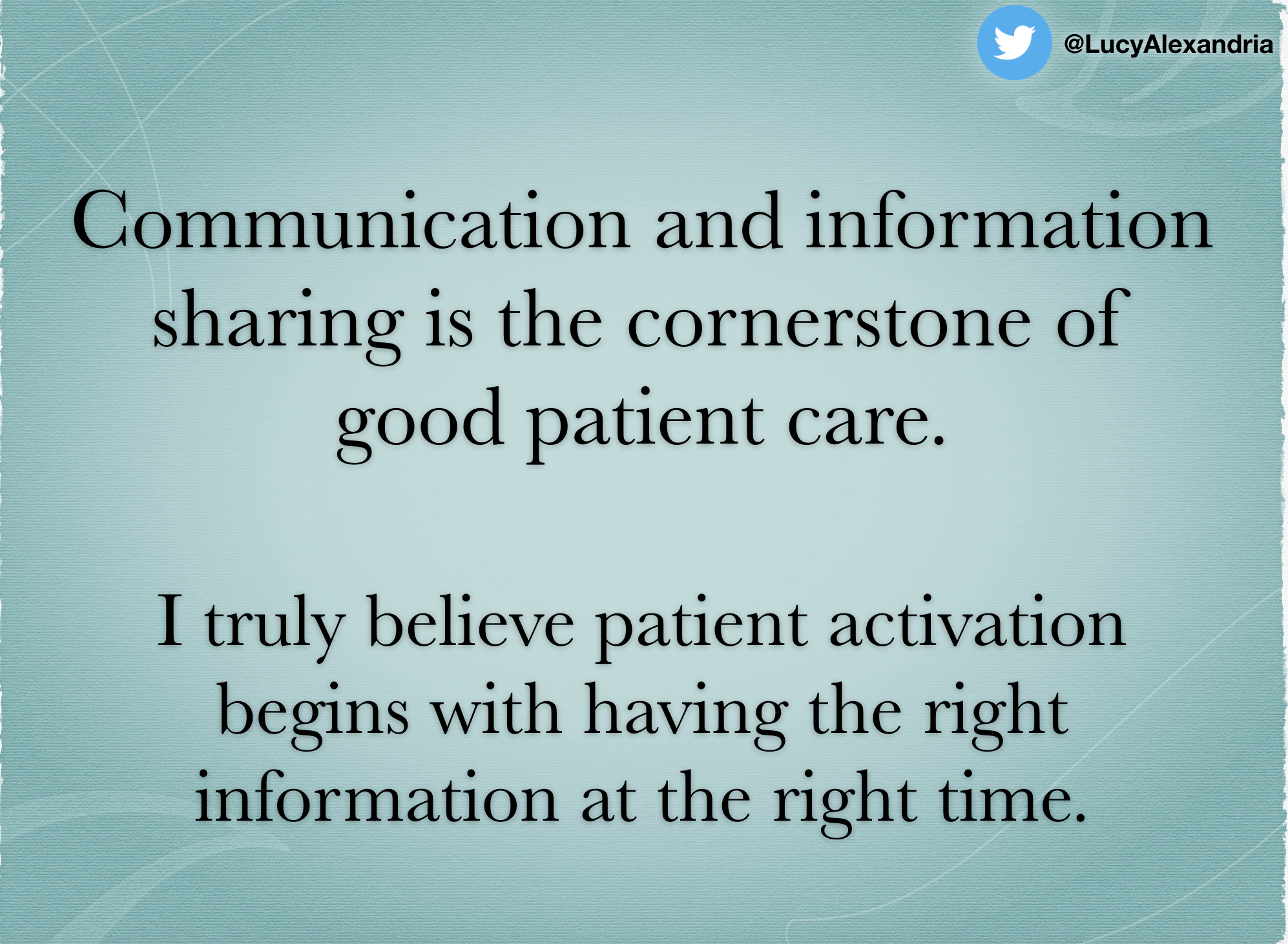
Barriers to information sharing
There are many barriers to information sharing and many of us attending the event, and indeed professionals more generally and some engaged patients, will understand what the barriers to information sharing are and all Caldicott Guardians know how crucial it is to protect that data and keep patient’s safe. However, many professionals do not understand the Caldicott Principles and what is and isn’t okay, and this creates issues, often erring on the side of caution and not sharing to prevent sharing the wrong information to the wrong people at the wrong time and in the wrong way. Also, professionals are under a huge amount of strain and so information sharing has a barrier in that respect, as sharing information can take time and so seamless information sharing doesn’t always happen – and in some cases, it usually or often doesn’t, causing a deficit in the knowledge of everyone in the team as they haven’t received the information as it hasn’t been shared with them. At the end of my speech, I was asked what I felt the biggest barriers are to seamless information sharing, and I said the biggest issue is a lack of understanding of what information can and should be shared, when, where, how and to whom, what the Caldicott Principles are and what their responsibilities are and where the boundaries are, what the law says, and what information shouldn’t be shared, when, how and why. This creates fear in professionals as they do not want to do the wrong thing, so they don’t share that information – or at best, they delay it until they can talk to their organisation’s Caldicott Guardian and understand what to share, when, how much and to whom they can share if with and where the laws and boundaries are and ensuring the patients’ information is shared only as much as is necessary and to whom is necessary, respecting the patients’ right to privacy and complying with data protection regulations (GDPR).
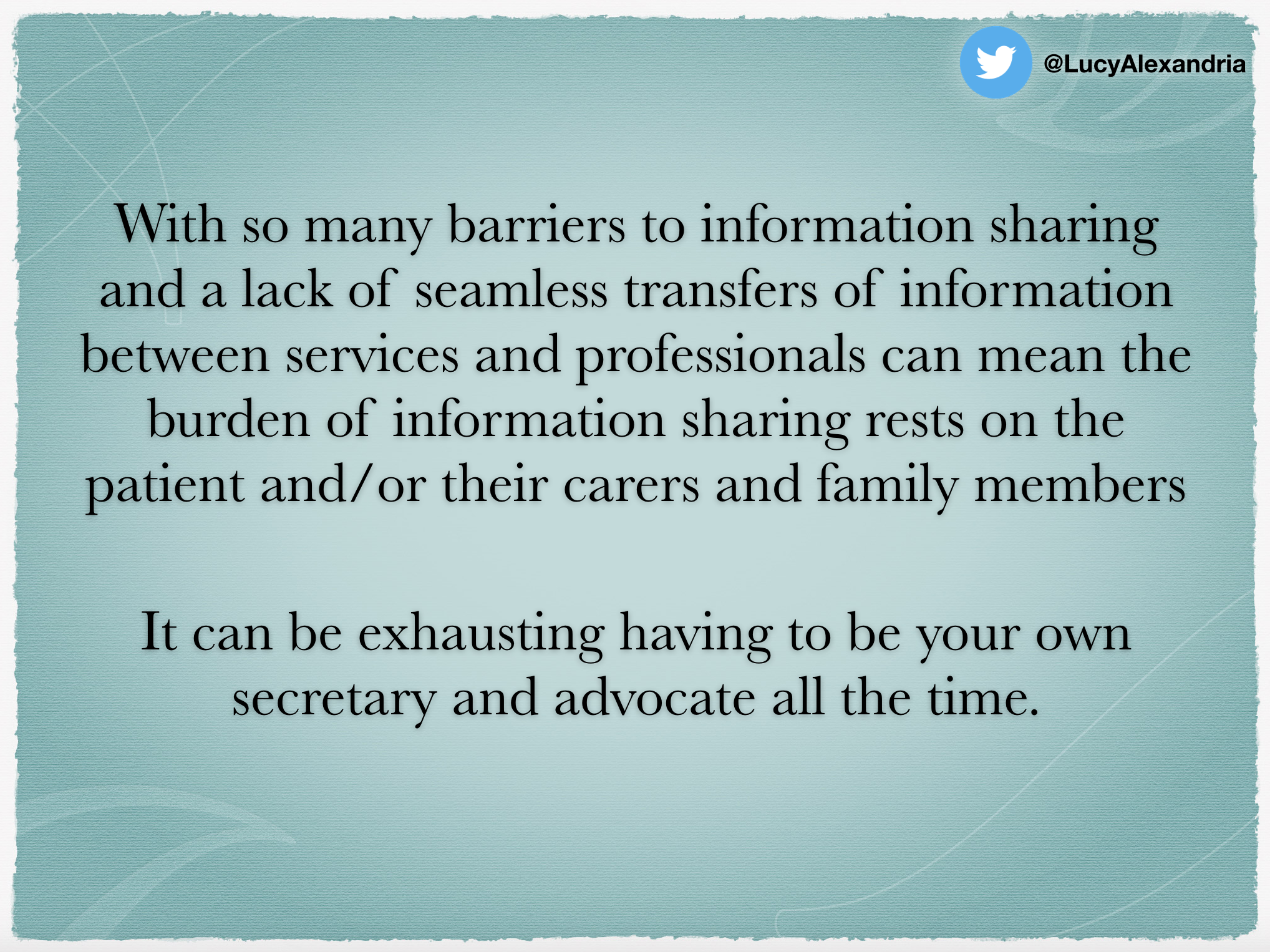
Barriers push the information sharing burden onto patients and carers
With so many barriers to information sharing and a lack of seamless transfers of information between services and professionals can mean the burden of information sharing rests on the patient and/or their carers and family members. This is difficult enough for patients if we are well, let alone if we are approaching end of life, and equally the burden on carers and family members is also tough, especially when all they want to do is spend quality time with their loved one. It can be exhausting having to be your own secretary and advocate all the time. Myself and my mother are forever being the go-between, sharing information with various doctors, departments, hospitals, specialties, services and professionals. It is like a full time job on its own. Once again, I fall back on my knowledge of my condition, the system and who I need to contact for what and when, whereas
If I wasn’t such an activated patient and didn’t understand and take on the role of information guardian and sharer, the information would end with me and my care would be drastically poorer, because the information wouldn’t have been shared around. It so often does rely on the patient and their families to share that information amongst the professionals, teams and services involved in supporting them. Why should we be in charge of information sharing?
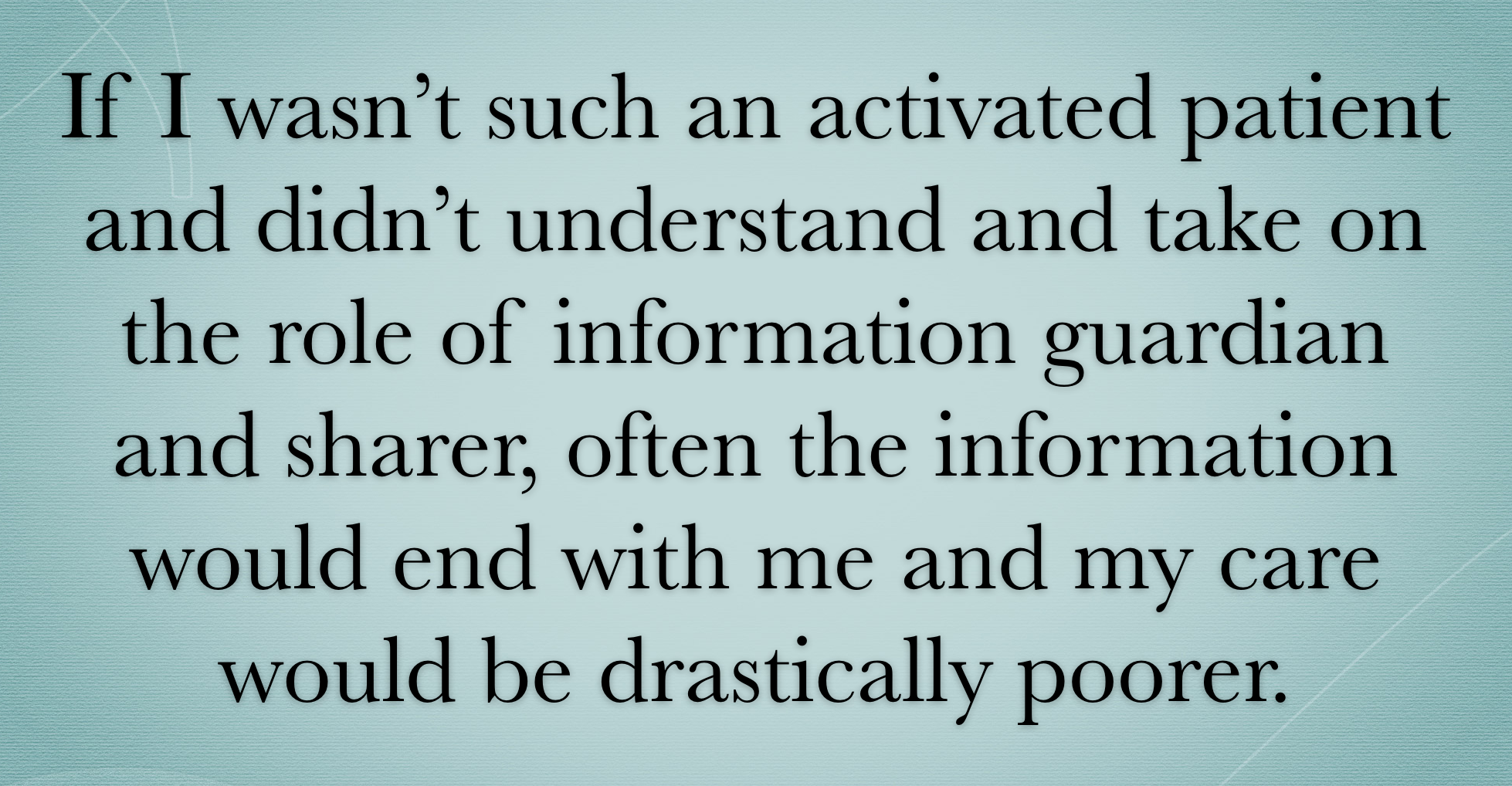
The transfer of information between professionals and services should be seamless and automatic, in my opinion, unless a patient has stated that they do not want information shared with certain professionals. It should not always fall to the patient to do this for themselves or on their carers. Whilst I am an engaged and activated patient, I do not feel it is my responsibility to be the go-between and information sharer all the time, as it is a burden patients and carers carry and they shouldn’t do.
Information sharing at end of life – even more crucial
At end of life, information sharing is especially crucial. We are particularly unwell and vulnerable and we need information to be shared amongst those caring for us without having to take that on and be the bearers of information between everyone involved in our care. It’s also crucial that any professionals have access to our summary care records and other information so they know how best to support us, what to do and crucially, what our wishes for end of life are. Mistakes will be made if professionals do not know our wishes and preferences.
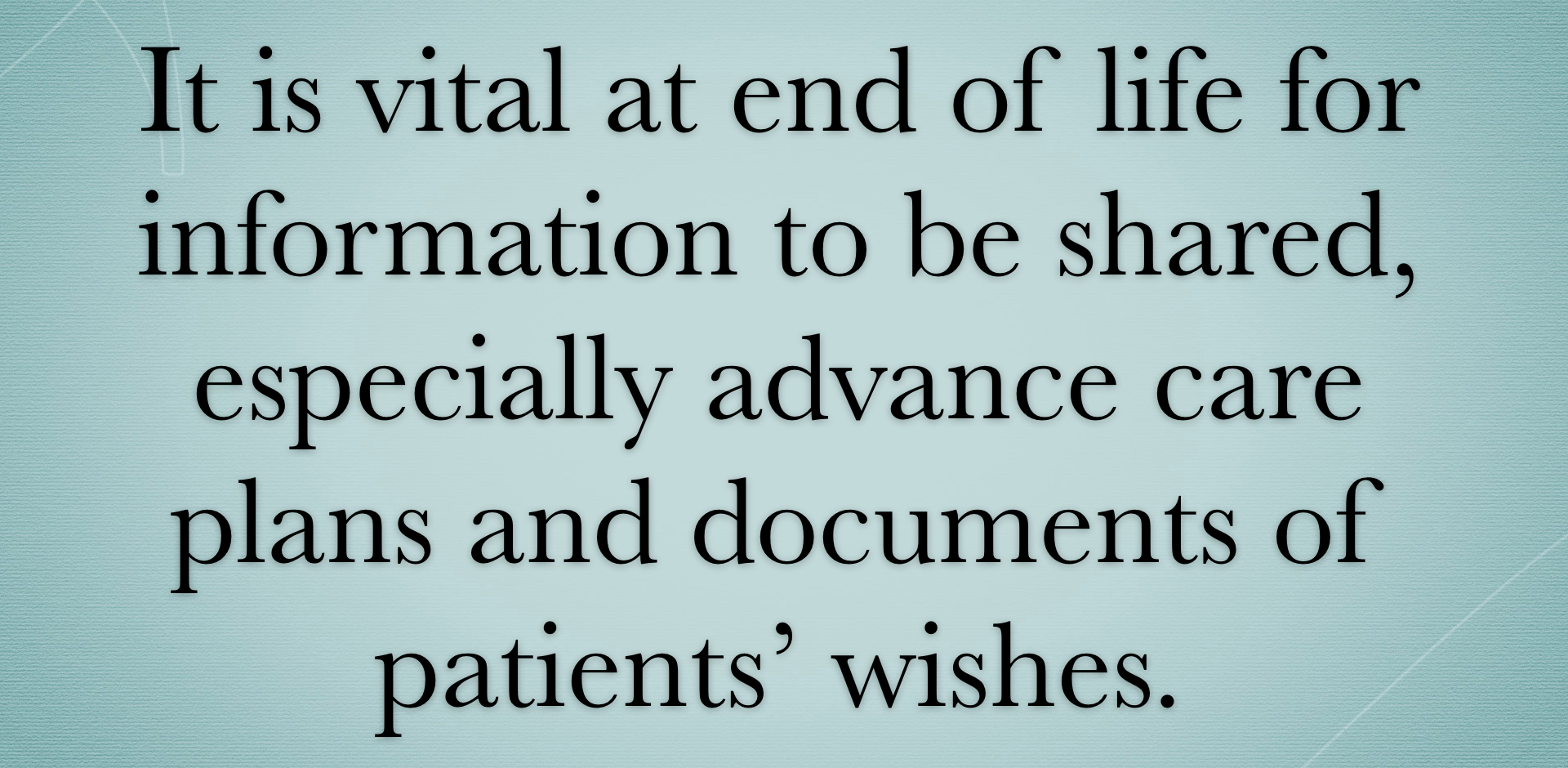
My experiences
I did my first advance care plan in 2011, and am currently updating it. I am on the local end of life register, knowing that whilst I am not terminal right now, my condition could easily become imminently terminal at extremely short notice; especially as my condition is so rare, it does not have a name and we do not know what has caused it, but we do know it is progressive and we know it’ll shorten my lifespan considerably.
I have various care plans with various organisations, including with the hospice, with the community nurses and with the CCG who fund my Continuing Healthcare package, in addition to my advance care plan itself. Previously, there was a disconnect between my care with the NHS, and my care from the hospice and my care from the palliative care team. This meant I was the information sharing tool, relaying my NHS care with the hospice and palliative care team and vice versa. I would constantly have to remind both sides what was happening and remind the NHS what my wishes were, especially my GP whom I do not have a lot of contact with but whom forms an essential part of the day to day management of my care through prescriptions and referrals and so on. He did not have access to my advance care plan other than the copy I handed him, which inevitably disappeared into the abyss of paperwork each time.
SystmOne and its impact on my care
However, now the local hospices are integrated into SystmOne, meaning there is a seamless transfer of information between all local services and organisations and the hospice. Having SystmOne means that any health and related professionals in the local area can access my health records and as such, have access to my advance care plan documents. This is crucial to supporting me effectively at end of life. For example, phoning the on-call GP could lead to the suggestion of an ambulance to go to hospital whereas my preference is to remain at home and if the on-call GP has access to my advance care plan, they can make steps to know who to turn to in order to try and fulfil my wish of remaining at home. This is very important to me. It has already benefitted me in that services know I wish to remain at home whenever and for as long as possible and knowing this via SystmOne means they can tailor my care to my wishes, and have done so previously.
SystmOne has streamlined information sharing in my own case, since the hospice, community nurses and GP are all on the same system and can access my records. This means the hospice, for example, can access discharge summaries from hospital admissions, rather than me having to take copies of the discharge summary and give hard copies to the relevant professionals. This has meant the hospice have got a constant updated record of my health, care and needs through access to my records via SystmOne. This is one less thing I have to worry about; the burden is not on me to share information with the hospice and my palliative care consultant, rather they have access to it via SystmOne. It also means the hospice and palliative care consultant know what has happened in my health and what treatments were given and should I present to them asking for help, they have the knowledge behind them of what has and hasn’t been done or tried and thus how they can help me best.
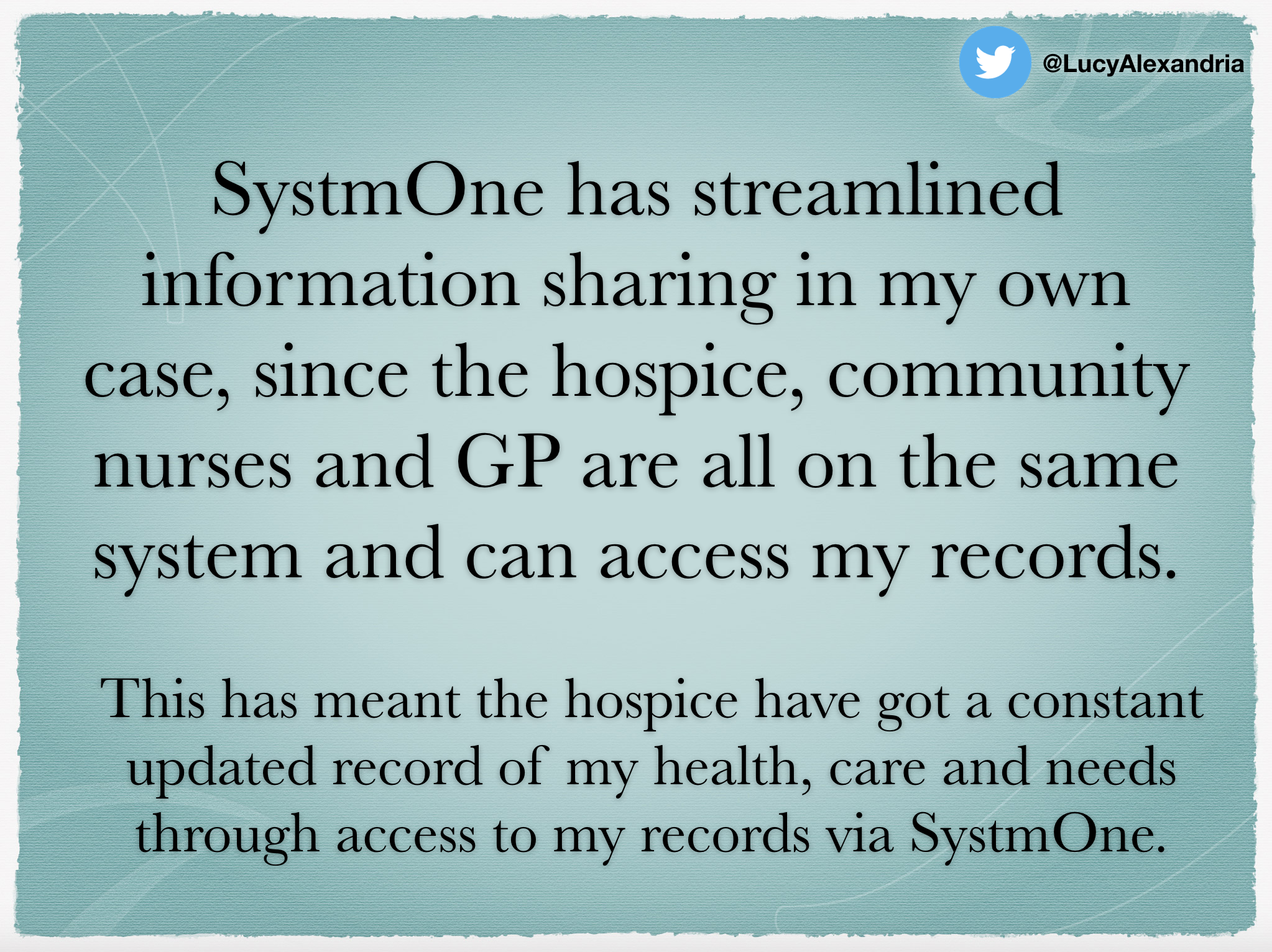
EPaCCS
Electronic Palliative Care Co-ordination Systems (EPaCCS) such as those used as part of SystmOne are a vital way of documenting patients’ wishes and communicating these across systems. EPaCCS enable patient choice, shared decision making, personalised care and support planning and integration across sectors, and enable true personalised, joined-up care. Having that central record of my wishes and needs, through my advance care plan and my personalised care and support plan, means that information is easily available and my care can be tailored and built around that plan, but also all professionals accessing the system know my needs and wishes and can build my care or their input around those needs and wishes.
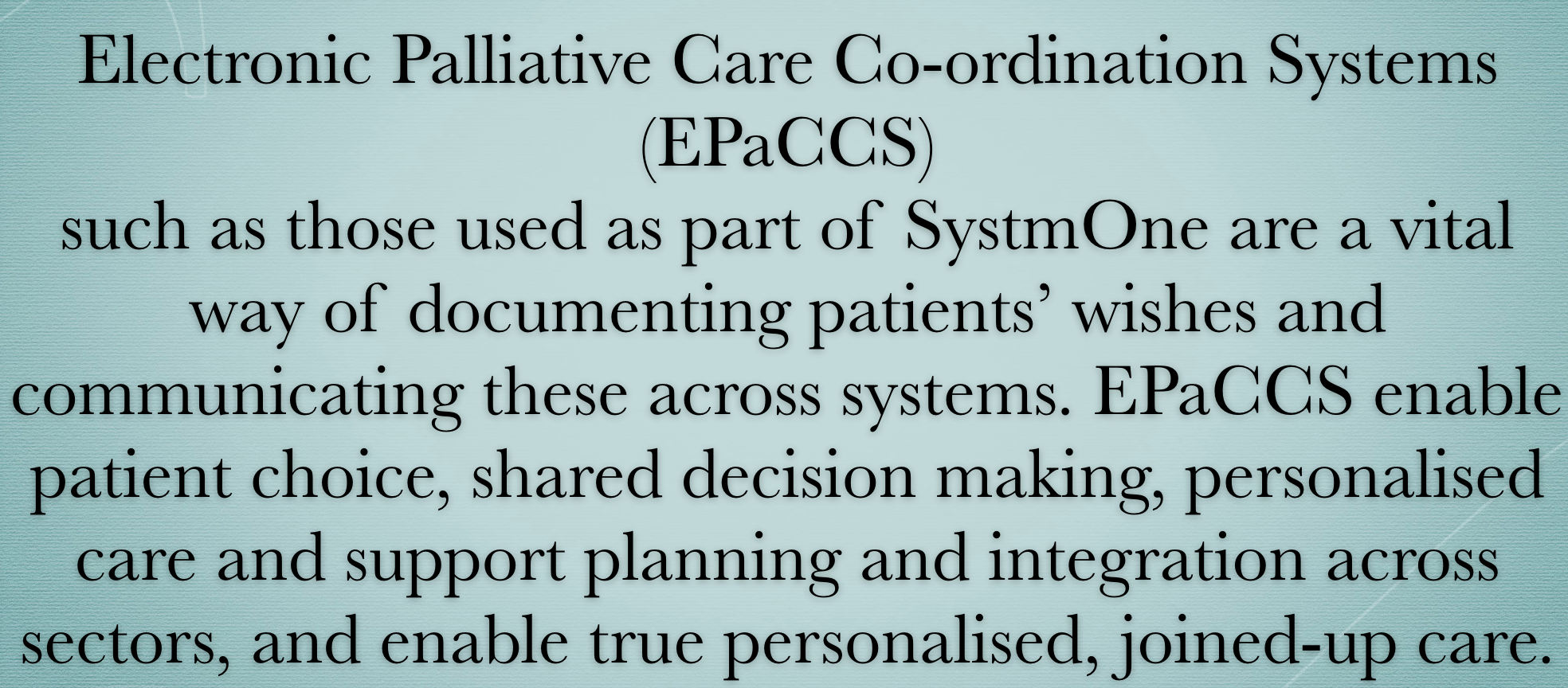
The biggest barrier to information sharing?
One of the biggest barriers to information sharing at end of life, is actually about professionals and patients and families having the courage to have difficult conversations at the earliest possible time.

We need to have conversations early, document wishes, and review these wishes as they can change over time and over the course of illness; a patient initially may want aggressive treatments at all cost, but a few months down the line may have altered their perspective and decide they don’t want to be resuscitated and/or that they would rather halt aggressive treatment. Knowing these wishes and reviewing them regularly are crucial, and equally as crucial is the wishes of the patient being communicated to all professionals involved in their care, ensuring everyone is effectively on the same page. Information sharing at end of life is crucial to join up services around a patient, but it’s also key that the patient has had their thoughts, wishes and views inputted into that record of information, namely through their advance care plan.
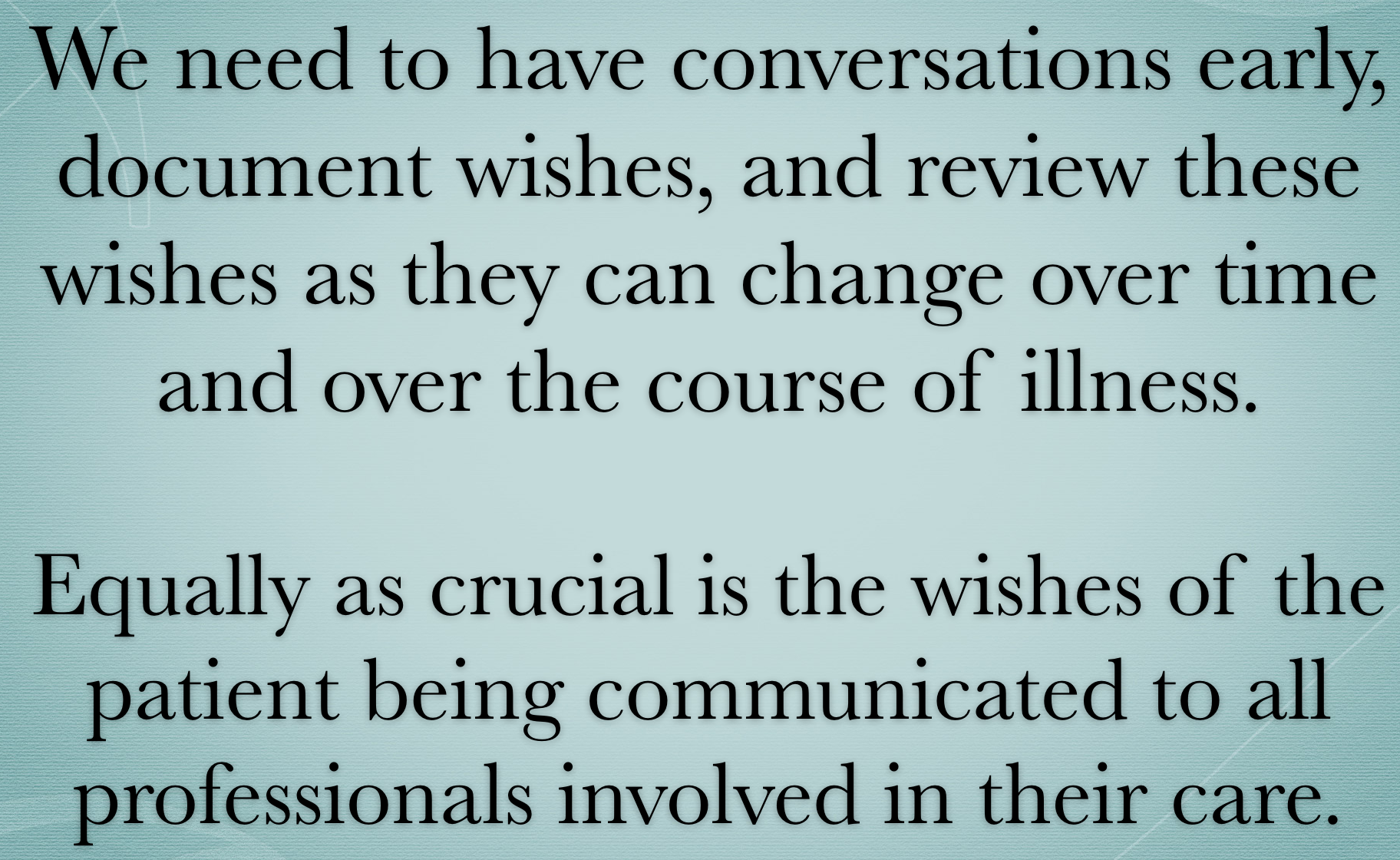
If we don’t know wishes, how can we seamlessly and effectively communicate the patients needs, decisions and preferences with others?
Also, patients need to understand how their data will be used, by whom, when and why, in order to give informed consent about how their own data is used. Conversations about data sharing are crucial and it’s good for patients to know who will have access to their data and how that may be used and to reassure them that their data is safe and secure and knowing there is someone in the organisation who is the guardian of patient data.
Patients and carers need the right information at the right time
Patients and families having the information they require is crucial. It is important that professionals give patients the right information at the right time and that their understanding is checked and questions can be asked. Also, it is important professionals know where to send patients for further information. Giving them links to utilise or websites to visit will ensure the information they receive is the correct information, and is not overly optimistic but equally not unnecessarily distressing or worse still, that the information is not incorrect and unsafe. We need to be educating and empowering patients and families to understand their situation, understand their condition, understand the care and services available to them and what their rights are.
They need to be informed, educated and able to understand what is happening, why and who is involved in their care, and that they understand implications of decisions they may be making, also. Information sharing is crucial to inform patients and ensure they understand everything, and patients need to understand the whole situation and not just parts and be encouraged to be active in their care and to become their own expert. They also need to understand that they are in control of their lives and care and that their wishes are paramount to their care.
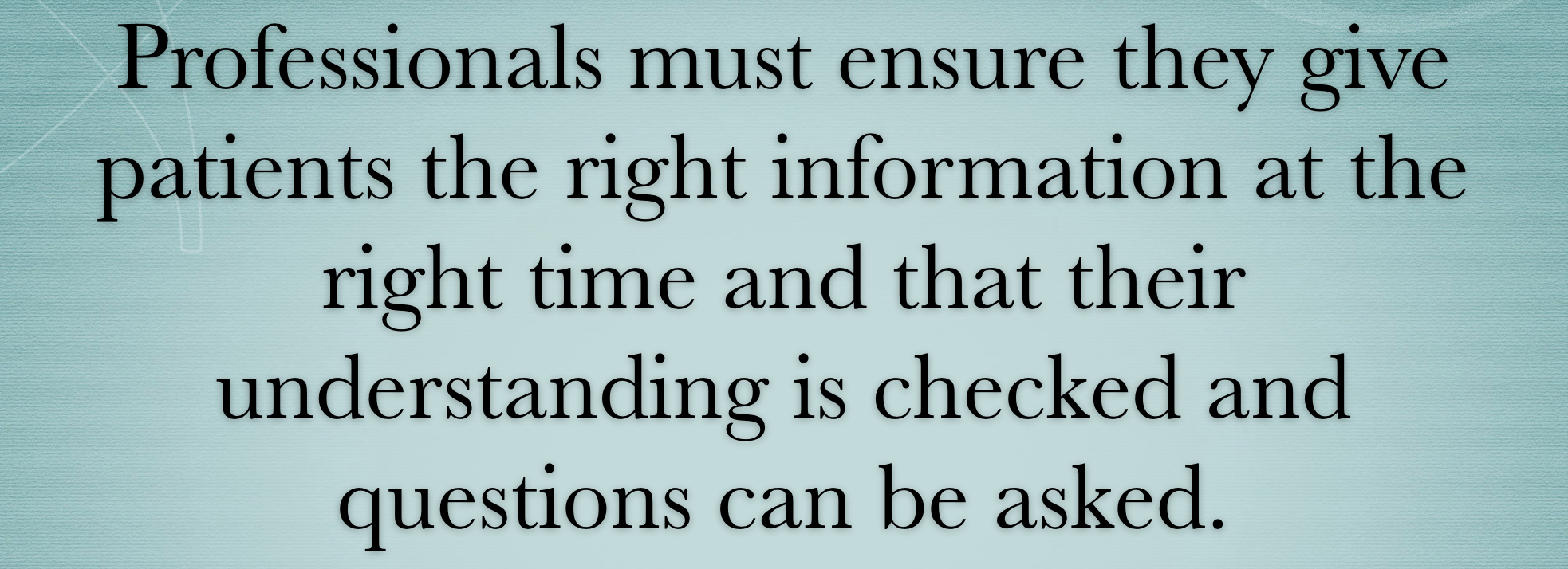

There are times where patients and carers need to be the driving force….
Despite what I have said above about the burden not falling upon patients and carers, there are times where we as patients do need to take an active role in being the drivers of information sharing. It’s important that patients can have a say in who receives what information and how this is shared and also it is important patients know they are able to utilise many different tools to support them. One thing I did want to mention from the patient side, is the fantastic mydecisions website, which allows patients to complete their own statement of wishes online, print this off and to share it with professionals involved in their care. It is not a replacement for full advance care planning between patients, families and professionals, but would enable them to write down their wishes and preferences themselves via the my decision website and then share this around.
Multi-agency working, key workers and integrated care
Services and professionals working together is another crucial aspect to information and the integration and joining up of services are vital. Multi-Agency working is crucial for patients like me. I have an especially complex condition that is managed by numerous professionals from a range of organisations, both locally in Essex and here in London, and coordinating my care can be a challenge. At one point I had more than 10 consultants as well as my GP, district nurses, the hospice, my Continuing Healthcare nurse, Occupational Therapist, Physio and others, and coordinating this was a mammoth task that fell on myself and my mother. Sharing information is one aspect of multi-agency working, but it goes deeper than that.

Professionals must be able to see the patient as a whole and see themselves as a cog in a larger machine, everyone plays their individual part but the machine won’t work unless everyone works together. Patients, as with information sharing, should also not be forced to be their own care coordinators.
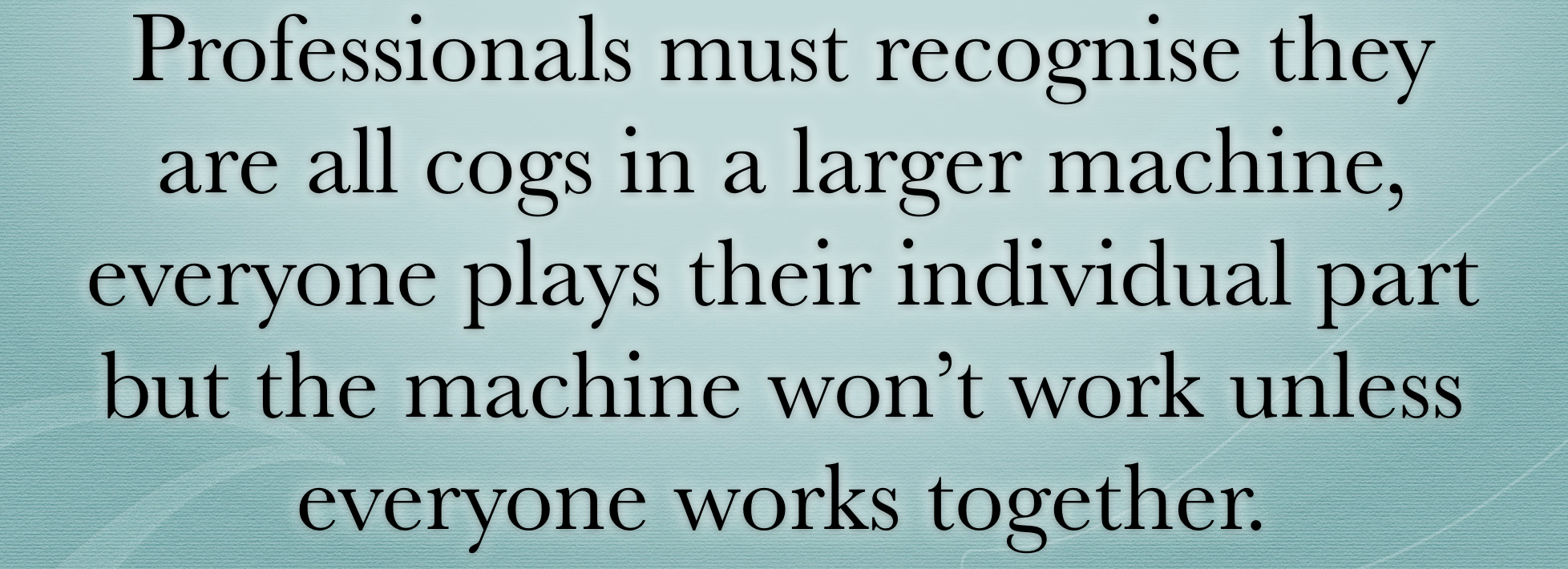
Having a key worker to take the role of coordinator and overseer of patients’ care would make such a huge difference, take the pressure off patients, allow better communication with patients and their families and draw together services and have a single point of contact for both the patients and their families, as well as the professionals within that patients’ care team. They can also act, in a way, as a form of Caldicott Guardian, being the individual in charge of that patients’ data and the sharing of such information, removing that burden from the patient or carer but also safeguarding that information, too.
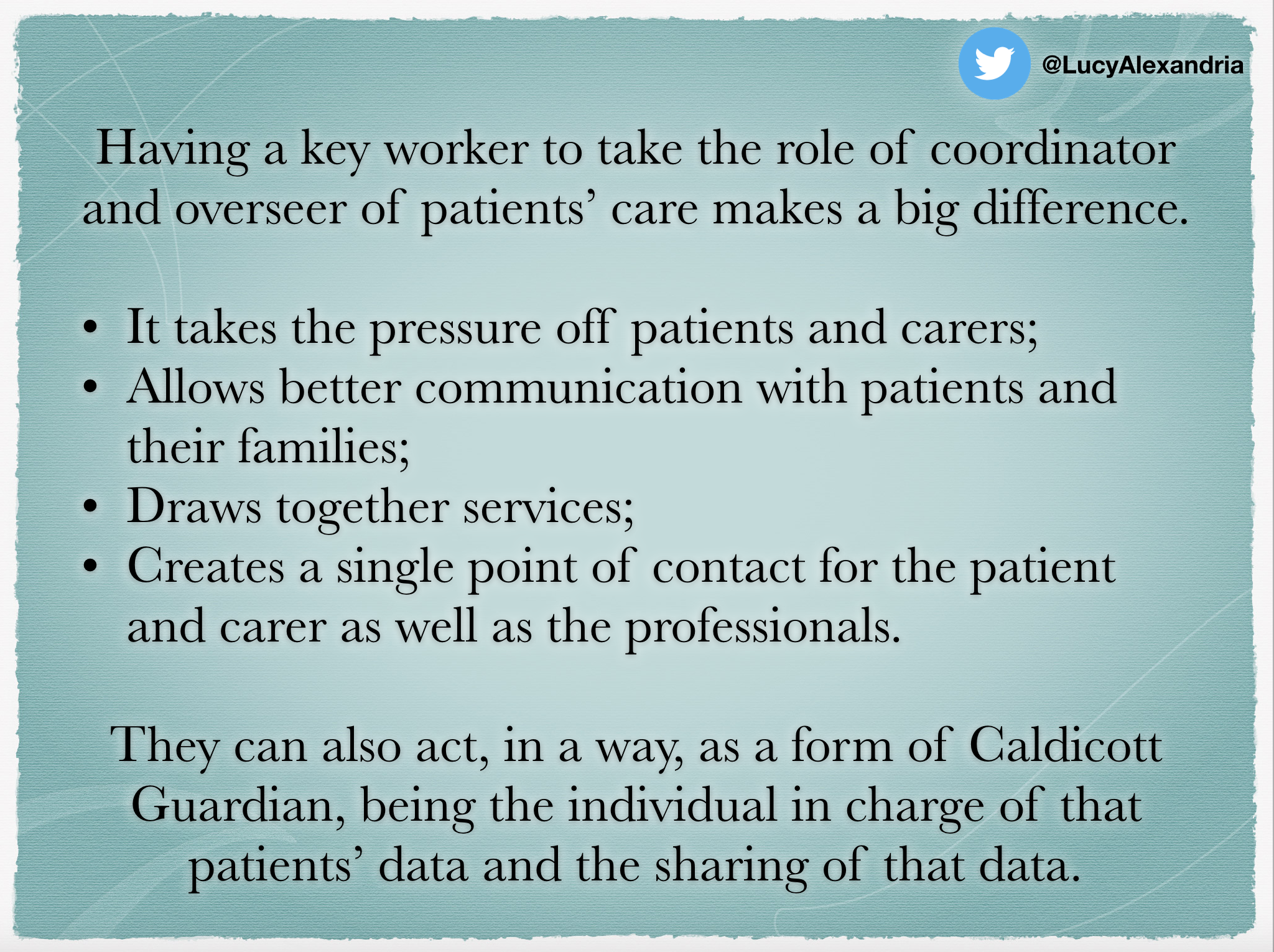
Multi-agency working and joining up of services is not only necessary, but it makes life easier for everyone. In my own care, whilst we are still often the care coordinators, there is some multi-agency working and the hospice do endeavour to be my care coordinators as far as possible. In my case, locally I have my GP, my GP Practice Nurse, the District Nurses, my Occupational Therapist, the hospice and my palliative care consultant who have shown they can work together when needed. As I mentioned, my preferred place of care is at home and where I am able to be kept at home, the hospice or palliative care consultant can work with my GP and the district nurses, and myself, my mother and my home care team, to try and manage the situation or symptom at home. Without multi-agency working, this just isn’t possible. The integration of care amongst services is important and I truly believe more patients should have access to an integrated package of care to draw together all the various professionals and services into their care.
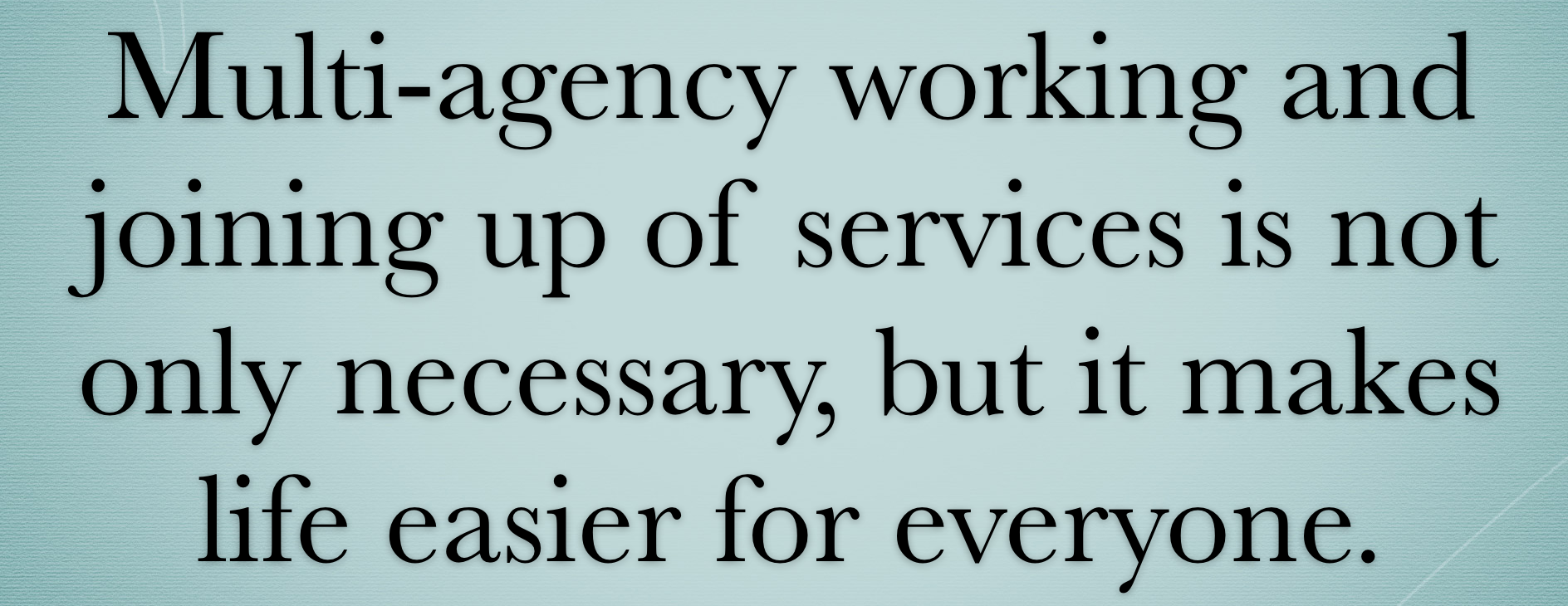
Commissioning my own care
For example, I have a Personal Health Budget and have previously been able to commission support from the hospice myself, and built into my PHB is an integrated approach, ensuring I know where everyone fits into my care package and who to contact and when, and I can commission services to meet my needs as long as they meet the outcomes specified in my personalised care and support plan and it is agreed by the Clinical Commissioning Group.
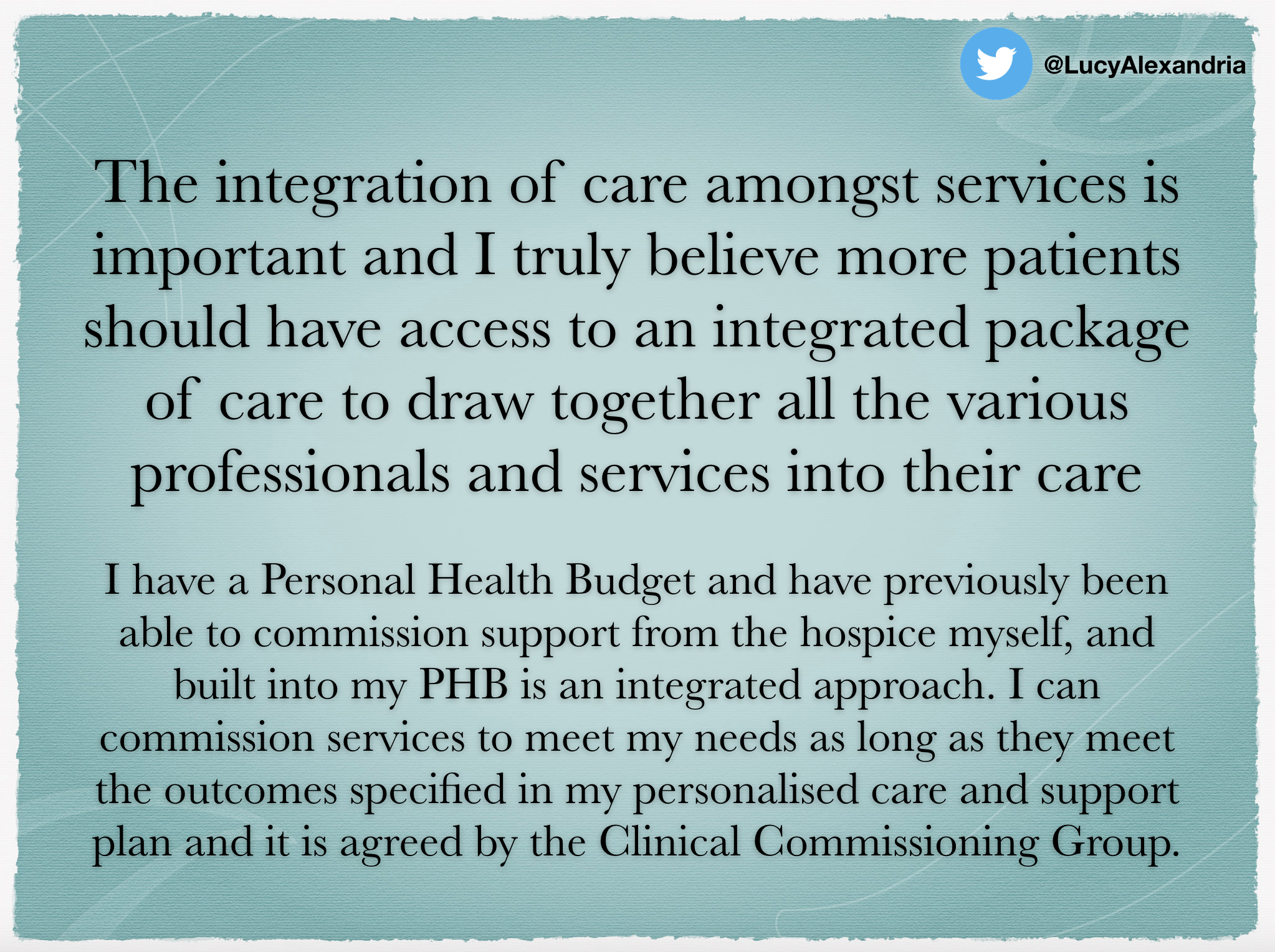
Parents, partners, families – an important part of the equation
Also important in this equation are the parents, partners, carers and other family members. I truly believe information sharing for families and carers starts with a carer’s assessment. If you don’t know and understand the carer or family’s needs, how can you best support and provide information to them? You need to have early conversations with carers and family members to as certain their understanding and thus tailor the information you provide. Also, little things like asking the carer or family members names, their preferred method of information provision, how they’d like to be contacted and if they have any questions or preferences.
At end of life especially, the carers and family members will often be the main caregivers and it’s important they have access to the information and support they require to safely and effectively care for their loved one at end of life.
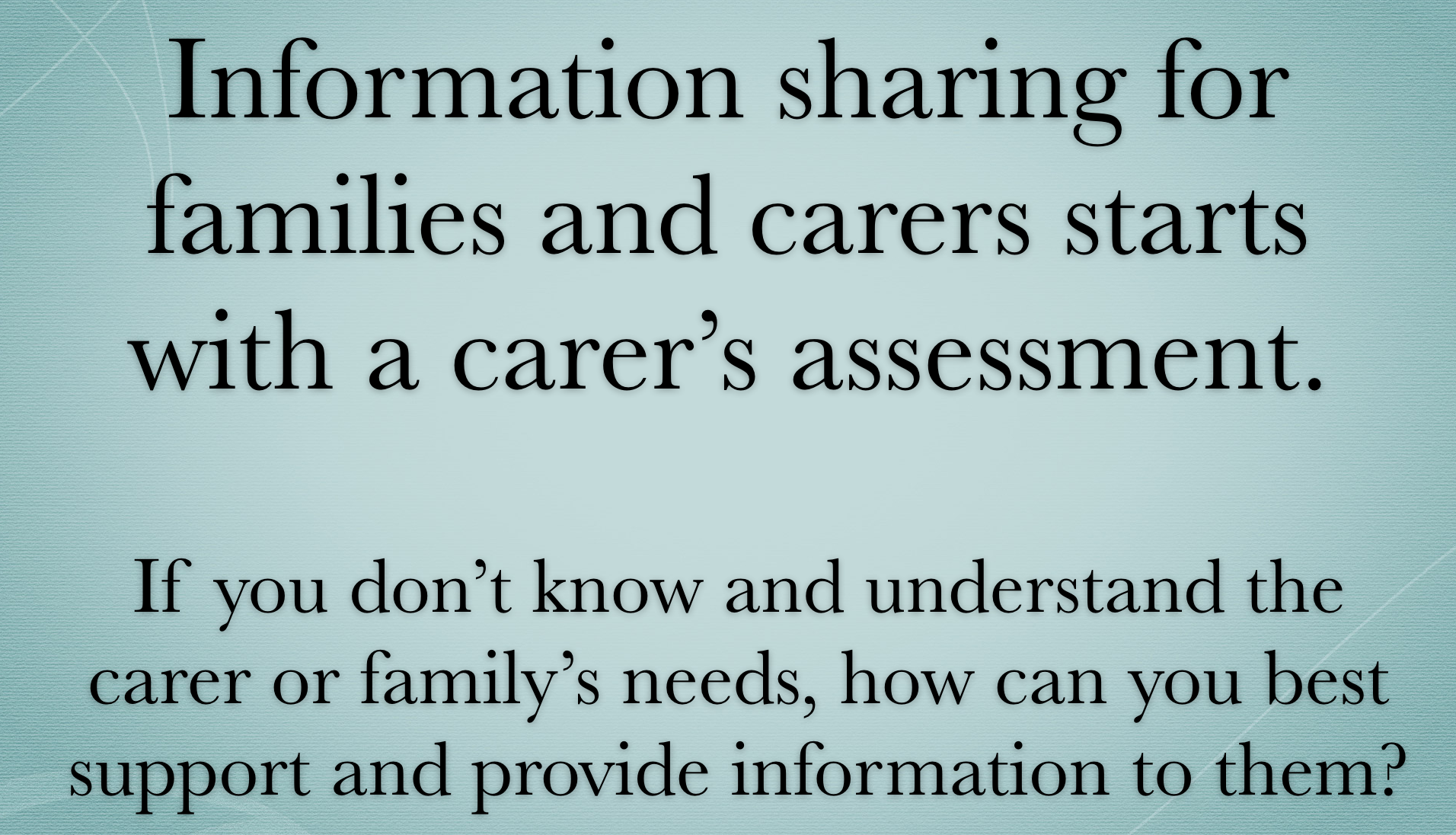
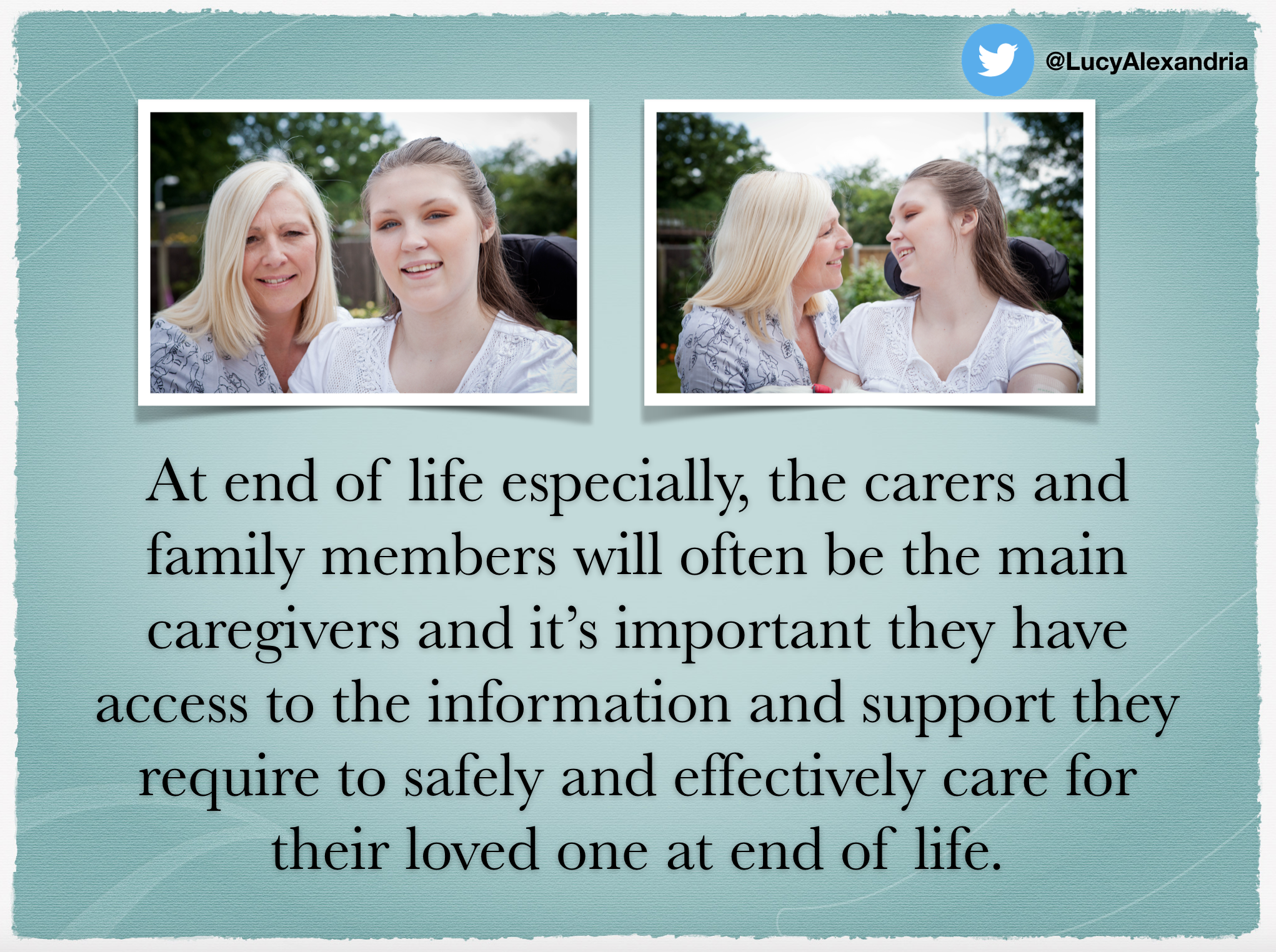
Patient held records
A professional at the conference at the end of my speech asked me if I have experience of and what I think about patient held electronic records. I’m not sure why I didn’t include this in my speech as I talk about it often enough on my travels as it’s something I’m truly passionate about. I explained that I knew of a platform called Patients Know Best which has been around for a long time where patients and consultants and other medical professionals could access the patients’ medical records held on the PKB system, but it came at a cost and was not universally utilised, giving the example of some departments at a leading children’s hospital using Patients Know Best and other departments not using it, so it wasn’t even universally used within one hospital or NHS Trust. I explained how those that used it loved it, but I have no personal experience of PKB or a patient accessible electronic record or patient portal or whatever terms it comes under as I’ve heard them referred to be various names over the years. I forgot to mention the GP Patient Online summary care record which patients can access. I went onto day that I desperately want access to a digital portal or app or record of all my medical notes, records, test results, scans, of love it all in one place, however to go one step further, I would like it so that patients’ could also interact within that portal/record/app, such as uploading a weekly/monthly/regular update from the patient so that can feed back to their team and feed into their care without having to have an appointment with their GP, consultant or other professional, and could upload documents of relevance or care plans or assessments to enhance their care. This would transform patient care, I believe. I got a lot of nods as I was answering this question.
To sum it all up…
Good information sharing is a cornerstone of patient care and we must remove the barriers to information sharing and care integration. We must recognise the crucial role carers play in the patient’s life, and ensure support and information is given to the carer’s and family members as well as the patient. We need to remove barriers to information sharing amongst professionals and services and to appoint a key worker – who, in effect, would take on a Caldicott guardian type role in that individual patients’ care, being both the guardian or gate keeper as well as the information sharer for that individual patient and becoming the care coordinator, to streamline the patient’s care and enable the best possible care and outcomes for the patient and their carer’s and relatives. We must ensure patients have the right information at the right time and that information is shared easily and seamlessly amongst the professionals and services involved in their care.
We all have the power to change lives; effective information sharing truly can transform lives and transform care. We must ensure we safeguard patient data, but this shouldn’t be seen as a barrier to seamless information sharing. We must ensure, at end of life, patients’ wishes are a top priority and ensure advance care plans and other documents are shared amongst and utilised by all professionals and services involved in a patients’ care, to ensure they have the support needed to have a good death.
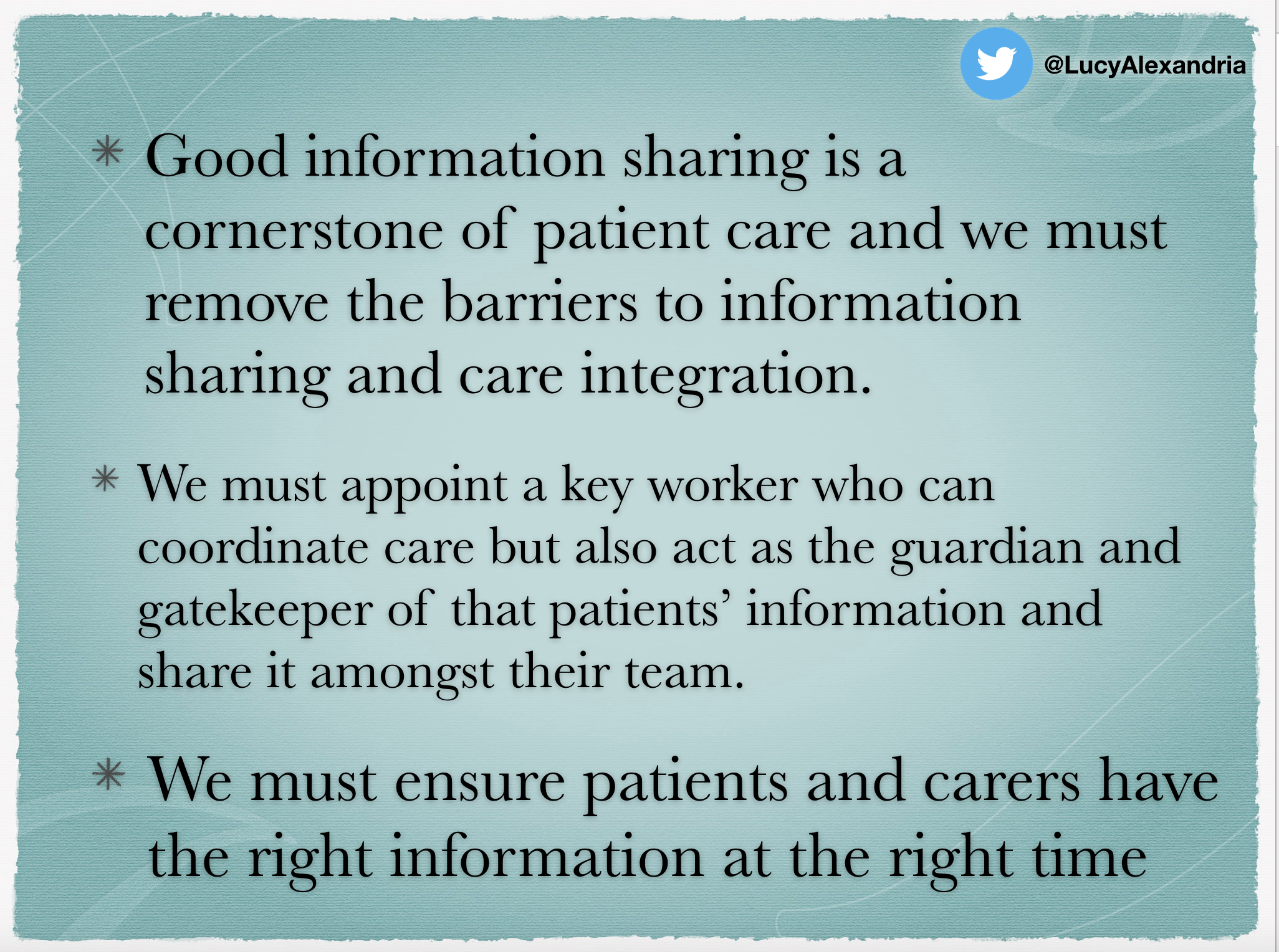

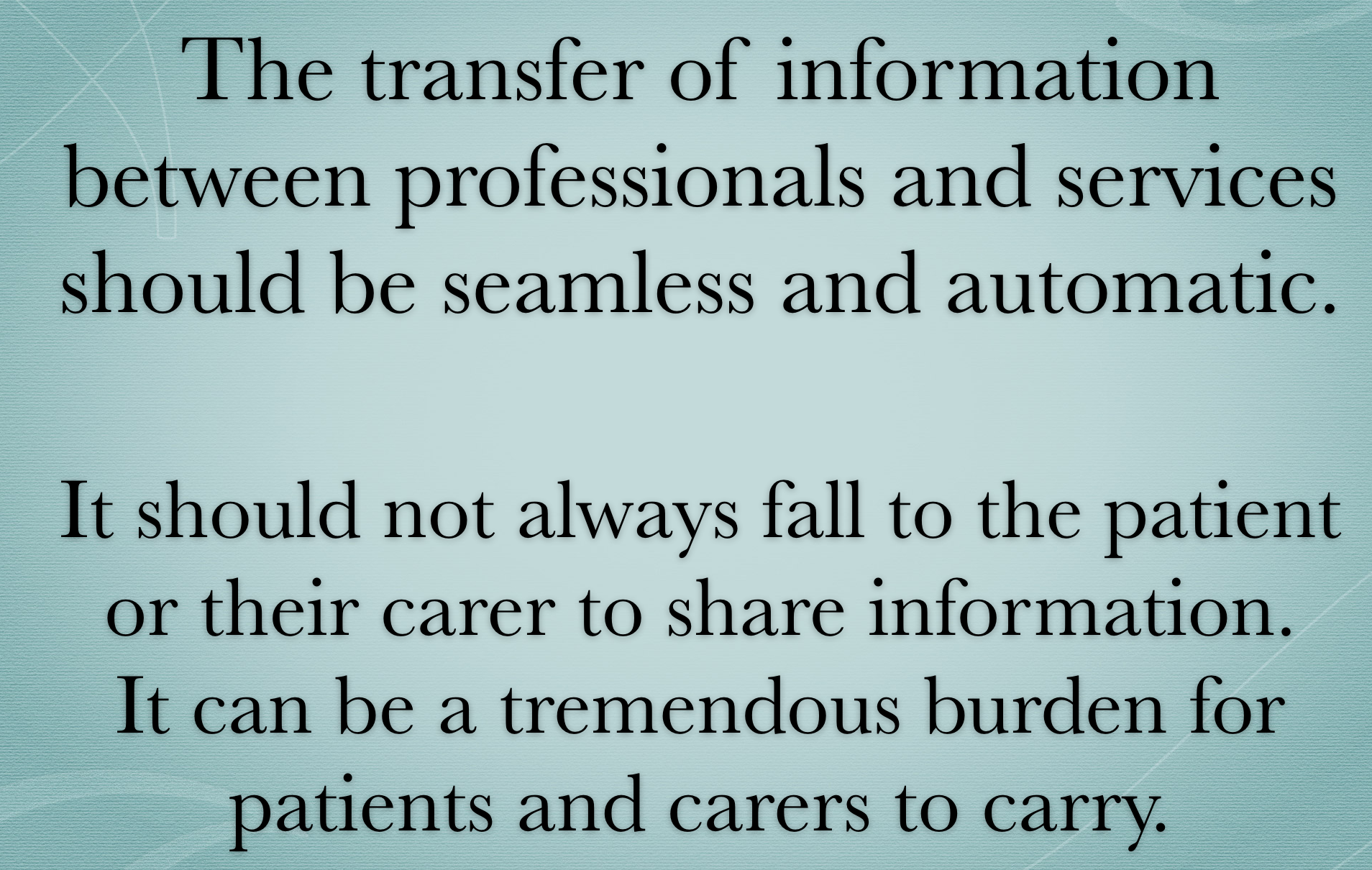



This Post Has 0 Comments